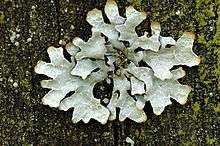Parmelia (fungus)
| Parmelia | |
|---|---|
 | |
| Parmelia sulcata | |
| Scientific classification | |
| Kingdom: | Fungi |
| Division: | Ascomycota |
| Class: | Lecanoromycetes |
| Order: | Lecanorales |
| Family: | Parmeliaceae |
| Genus: | Parmelia Ach. (1803) |
| Type species | |
| Parmelia saxatilis (L.) Ach. (1803) | |
| Species | |
|
Several, see text | |
Parmelia is a genus of medium to large foliose lichens.[1]:78 The ends of the leaf-like lobes are often squarish-tipped.[1]:78 The upper surface is pale bluish-gray to light brown in direct sunlight, with a network web-like ridges and depressions.:78 The lower surface is black and has rhizenes anchoring it to the substrate.[1]:78
It has a global distribution, extending from the Arctic[2] to the Antarctic continent[3][4] but concentrated in temperate regions.[5] 125 species have been recorded on the Indian sub-continent.[6] Depending on whether the circumscription of the genus is considered in the narrow sense (sensu strico) or the broad sense (sensu lato), there are between 50 and 1322 species worldwide.[5] It is a foliaceous lichen, resembling a leaf in shape. In recent years, the genus Parmelia has been divided into a number of smaller genera according to thallus morphology.
Description and ecology
In general, Parmelia have a dark lower side with rhizines ('rootlets') which attach the lichen to its substrate. The upper side may be several colours - grey, yellow, brown - and may have reproductive organs on it. These may be apothecia (spore producing bodies), isidia or soralia (both vegetative structures). In between these two layers is the medulla which contains the algal component of the lichen.
Parmelia perlata is called Dagad (north India), patthar ke phool (Hindi), kallu hoovu (Kannada), kallu pachi (Telugu), kal pasi (Tamil). It is used as a spice that provides a distinct, unmistakable flavor.
Parmelia lichens are food for the caterpillars of certain Lepidoptera, such as the bagworm moth Taleporia tubulosa.
Selected species
- Parmelia asiatica
- Parmelia omphalodes
- Parmelia perlata
- Parmelia saxatilis
- Parmelia sulcata
References
- 1 2 3 Field Guide to California Lichens, Stephen Sharnoff, Yale University Press, 2014, ISBN 978-0-300-19500-2
- ↑ Skult H (1985) A New Subspecies of Parmelia omphalodes Ascomycetes Described from the Arctic. Annales Botanici Fennici 22, 201-6.
- ↑ D.C. Lindsay (1973) Notes on Antarctic lichens: IV. The genera Cetraria Hoffm., Hypogymnia (Nyl.) Nyl., Menegazzia Massal, Parmelia Ach. and Platismatia Culb. et Culb. British Antarctic Survey Bulletin 36, 105-114.
- ↑ J. Hooker (1847) The Botany of the Antarctic voyage. Vol. 1. Flora Antarctica. Part 2 Botany of Fuegia, the Falklands, Kerguelens land, etc. Reeve Bros., London.
- 1 2 Bisby, Guy Richard; Ainsworth, G. C.; Kirk, P. M.; Aptroot, André (2001). Ainsworth & Bisby's Dictionary of the fungi / by P. M. Kirk... [et al.]; with the assistance of A. Aptroot... [et al.] Oxon: CAB International. p. 378. ISBN 0-85199-377-X.
- ↑ Awasthi D.D. (1976) Lichen genus Parmelia in India. I. Subgenera Parmelia and Amphigymnia. Biological Memoirs (Lichenol. Ser.) 1: 155-229.